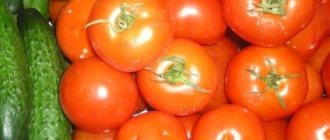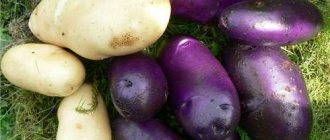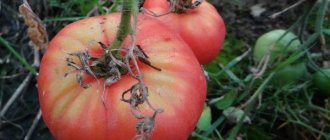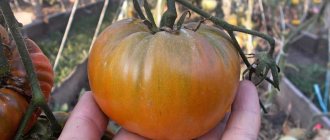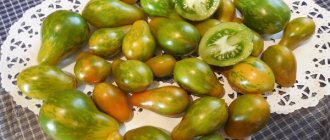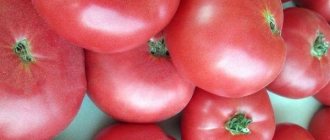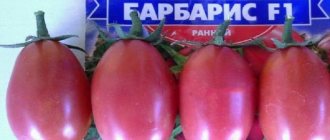For owners of personal plots, it is first of all important to obtain a decent, high-quality harvest.
When choosing a particular variety, they are guided by the characteristics of the plant. Growing tomatoes involves some difficulties; the product may die, and also does not retain its properties when preserved. In this article we will look at the new variety of tomatoes “Ladies' Man”, its main characteristics, planting and care methods. Dear readers! For you, we have created communities on social networks in which useful articles and interesting ideas are published several times a day! Subscribe and receive useful content in a convenient format!
Characteristics, description of tomato Ladies' man
The branched bush can grow up to 180 cm, but special supports are required, otherwise the plant falls and breaks.
The highest yield is observed when 2-3 rough stems are formed. The leaves are round, slightly elongated, dark green in color. The fruits are large, weigh about 60 g, and are bright red in color. They are elongated in shape and have a pointed end. The skin is smooth, does not crack, is covered with a thin layer of vegetable wax for protection, and can withstand raindrops and even small hailstones, so the tomatoes remain intact until harvest. The pulp is dense, juicy and sweet, and can be stored for a long time. The root system is strong, able to withstand short droughts, and produces fruits even in cold summers.
Description and characteristics of the variety
The tall indeterminate tomato Ladies' Man reaches 150-170 cm. The leaves are large and dark green. The fruits ripen early. They are medium in size, 120-150 grams each, although they can be smaller – 45-60 grams each. They have a beautiful cylindrical elongated shape, bright red color. The pulp is tender and sweet, contains a lot of juice. The variety is suitable for canning as a whole, as well as for salads, sauces, juices and various dishes.
Advantages and disadvantages
The Ladies' Man variety has become widespread among gardeners due to its many positive qualities, including the unusual appearance of the fruit.
- Tomatoes are early ripening, the first fruits ripen by the end of June.
- The variety feels comfortable both in closed greenhouses and on the site due to its unpretentiousness and rapid adaptation to the conditions of the growing medium.
- Tomatoes form ovaries even in unfavorable weather, which is why they are actively grown in regions with a sharp cold climate.
- The taste of the pulp is moderately sweet. It can be used for various purposes: eaten fresh, prepared in salads, soups or pickled. Its consistency is juicy, but does not contain many seeds.
- The fruits do not spoil for a long time and tolerate long-term transportation well.
However, there are several disadvantages of this variety, which are rather relative in nature:
- The bush requires constant care, including staking and pruning. The plants regularly form new shoots, so they are very branchy. In order for the fruits to appear in a timely manner, it is necessary to carefully monitor the growth rate of the greenery.
- In areas with bad weather conditions, tomatoes ripen a couple of weeks later than expected. But this only manifests itself when grown in an open area; in greenhouses, the bush bears fruit on time.
Description
Tomatoes Ladies' Man are an indeterminate and early ripening variety. The bush is tall, which is beneficial for commercial purposes. It can grow both outdoors and in greenhouses.
Plant
The bush is tall - up to 1.7-2 m. It needs staking on trellises or supports and pinching.
The inflorescences are intermediate, the ovary is formed after 2-3 leaves. For optimal results, the bush is formed into 2-3 stems. The leaves are large, dark green, slightly pubescent and elastic.
Fruit
The tomatoes are unusual in appearance: they have an elongated (oval) shape, a bit like bell peppers. The skin is glossy, smooth, and not prone to cracking.
The color at full maturity is deep red. The fruit size is small, average weight is about 50-80 g.
The structure of the pulp is granular, dense and juicy. There are only 3 chambers, there are not many seeds and liquid inside. The taste is sweetish.
Productivity
The productivity of tomatoes of the Ladies' Man variety reaches high levels (10-12 kg/m² and 3-4 kg per bush), but this will only happen if the correct agricultural technology is used in greenhouses.
If grown in open ground, the result will be 20-30% lower (it all depends on the weather and climate).
Area of application of fruits
Due to their universal qualities, tomatoes are suitable for consumption both fresh and processed.
Cut fruits retain their freshness and shape for a long time (do not spread). Due to their optimal size, they are suitable for pickling in jars for the winter.
In industry they are used to produce ketchups, sauces and juices.
Seedling growing method
You can grow healthy seedlings yourself if you follow some rules. It is necessary to pay attention to the climatic conditions of the area in order to determine the timing of planting. So, in the southern regions of the country, where the air warms up faster, the event is held in February-March, and young tomatoes are brought into open ground only at the end of April.
In the central part, sowing of seedlings falls in March-April, and you should not delay it too much, otherwise the fruits will not have time to ripen. For the site - early June; in warm weather, the dates move to mid-May. In Siberia, it is recommended to plant seeds no later than April, and in open ground - from mid-June. Dates may vary depending on specific weather conditions in the region.
Seed preparation
Before sowing seeds, you need to carry out thorough preparation in order to protect the tomato from diseases in the future and increase the germination and productivity of the bushes.
- Carry out complete disinfection. If seeds are purchased, they are disinfected in advance at the enterprise, but when collecting material yourself, this important step should not be neglected. There are several ways to carry out this procedure: Potassium permanganate. You will need 1 gram of substance per 100 ml of water, mix thoroughly. The seeds must be wrapped in a thin layer of cotton wool and immersed in the solution for 15-20 minutes. If you increase the time, germination will decrease significantly. After the procedure, you need to carefully rinse the material with water.
- Soda. The solution is prepared from ordinary baking soda and water in a consistency of 0.5 g per 100 ml. Seeds wrapped in gauze or a cotton pad should be kept in the infusion for at least 1 day, then rinsed carefully. This event will increase the yield of the bush.
- Fitosporin. Dilute 1 drop in 100 ml of liquid, immerse the material for about 2 hours, thanks to this solution, germination increases and seed adaptation improves.
- Aloe. A nutrient solution using aloe juice and settled water in a 1:1 ratio increases the immunity of tomatoes, protecting them from infectious fungal infections. Seeds need to be soaked for at least 1 day.
Landing technology
If you want to grow a decent harvest and high-quality fruits, then you should follow all procedures strictly according to the instructions, observing all the details.
Selection of planting material
Seeds or seedlings should only be purchased from trusted places, garden centers or nurseries. The choice of planting material should be taken very responsibly. How to understand that seedlings are of high quality?
- Tomatoes should be 45 - 60 days old; it is advisable to plant them together so that they are easy to care for.
- The leaves should be healthy, of a rich green hue, but if their upper parts curl inward, then you have a specimen that has been heavily fed with nitrogen-containing preparations. The height of the seedling must be at least 30 cm.
- The thickness of the plants is about the size of an ordinary pencil. Each healthy seedling has from 9 to 12 leaves. This amount is found in tall varieties of tomatoes, to which “Ladies' Man” belongs.
- Good quality seedlings are sold exclusively in boxes, but not in plastic bags.
- If you decide to grow seedlings yourself, then this procedure is done according to the basic rules. It is mandatory to treat the seeds with a solution of potassium permanganate and growth stimulants; a stratification procedure must be carried out.
- After germination in greenhouse conditions, the seedlings should be watered and fed, then plucked when several leaves appear. Next, harden it in the fresh air and plant it in a permanent place.
Soil composition
It is important to follow the rule of crop rotation: it is advisable to plant tomatoes in place of legumes, cabbage, carrots, onions or cucumbers. It is not recommended to grow tomatoes in place of potatoes, eggplants or peppers. After the latter, the soil becomes quite poor, and it takes 3 years for it to become saturated with nutrients.
- The acidity level (PH) should be around 7, that is, neutral, slightly acidic is allowed.
- You should not add too much organic matter to the soil, as this is unnecessary for tomatoes. This does not contribute to high yield and quality of fruits.
- The most successful soil will be loose soil that conducts air and moisture well, is nutritious, and fertilized with mineral complexes.
- In the second half of the summer season or early autumn, you should dig up the area and remove all plant remains. In the spring, the soil is also dug up several times and humus and mineral fertilizers are added.
- The area should be quite spacious, since the variety is tall. Dense planting can cause infections because air and light will not reach the plants in sufficient quantities.
- The ideal composition would be a mixture consisting of equal parts of black soil and peat.
Before planting, choose a dry day to prepare the site for planting the seedlings. It is necessary to plant seedlings after residual night frosts have passed and the soil has warmed up well.
Planting Tips
- Choose a place that is sunny and dry. Fresh air and sunlight are important for tomatoes. It is better to ventilate the greenhouse more often.
- Seedlings of the variety need to be replanted when one cluster is formed. The stem is buried 2 - 3 cm into the hole. The distance between plants must be at least 30 - 40 cm.
- After planting, you need to water the tomatoes at the root with warm water. Finally, mulch with straw, sawdust, and peat so that weeds do not take away nutrients.
- As the tomatoes grow, you need to remove the bushes and tie them up.
Transplanting seedlings into the ground
Correctly carried out transplantation is accompanied by the rapid adaptation of tomatoes to the new substrate and their active growing season in the future. In order not to harm the plant, you should follow certain rules:
- When the stem has reached a height of 15-20 cm, 5-7 healthy leaves and one brush have formed, the Ladies' Man is ready for replanting.
- You should also pay attention to the internodes - they should not be large.
- It is not recommended to replant tomatoes in too hot weather, strong gusty winds or even light precipitation.
- The best time to move seedlings to the site is a cloudy, cool day.
- The gaps between bushes should be at least 40 cm, since the variety has a very branched root system, and tomatoes growing close together can harm each other.
- You need to dig a planting hole about 10-15 cm deep, while the stem should not be buried more than 2 cm, otherwise it will begin to rot and the roots will not be able to fully strengthen.
- Before planting, the soil must be mixed with peat tablets and ash to provide greater nutritional value. You can also add a little organic matter - humus, urea.
- After completing the procedure, you should thoroughly water the bush at the root.
Seedless growing method
This method is recommended in warm regions where the likelihood of unexpected frosts in late spring is minimal.
First you need to decide on the location of the beds. The variety is photophilous, but does not tolerate direct sunlight, so it should be placed in the southwestern or southeastern part of the garden. When growing in a greenhouse, if there is not enough light, it is necessary to install phytolamps. The tomato requires warm, moist air, then it produces a large number of fruits, and the active growing season increases. Tomatoes grow well in soil enriched with peat; it can be a universal substrate or black soil with the addition of organic fertilizers. In order for the seeds to germinate, you need to carefully adjust the temperature, otherwise there is a high probability of the plant dying.
Planting seeds in the ground
Changes to the site should be planted with the onset of constant warm weather, that is, in late spring and early summer. The landing procedure is carried out in several stages:
- First, the material must be placed in a solution of growth stimulants for 10-12 hours to increase the rate of maturation.
- Approximately 40 cm should be left between planting holes and 60 cm between rows.
- It is not recommended to bury the seeds more than 3-5 cm, otherwise it will be difficult for the sprout to break through the soil layer.
- After sowing, you need to carefully moisten the soil so as not to wash away the seeds. This can be done using a spray bottle or diffuse watering.
- Sprinkle with a small layer of ash and black soil.
- With proper care, the first shoots should appear within 5 days. Only then can full watering be carried out.
Necessary conditions and care for tomato ladies' man
Although the Ladies' Man variety is unpretentious, it still needs to be carefully looked after in order to achieve maximum yield and avoid the occurrence of serious diseases.
Watering
Young shrubs are moistened in extreme cases, for example, during severe drought. For the first 2-3 weeks, watering should be carried out without affecting the green part, so that all the liquid is absorbed directly by the root system, then the plant will take root faster and begin to develop. In the future, the soil should not be allowed to dry out. Tomatoes are moisture-loving and with a lack of liquid they quickly wither. However, daily watering can harm the Ladies' Man, causing fungal infections and destroying the tomato. Thus, the norm for 1 bush is 3 liters as the soil dries.
Loosening
To provide the roots with oxygen, it is necessary to regularly loosen the soil: for the first 1-2 months after growing in open ground - to a depth of about 10-15 cm, and then no more than 8 cm, so as not to harm the overgrown root system. It is recommended to carry out this procedure after each watering, combining it with weeding of harmful weeds, at least once every 2 weeks.
Tying up
About 3 weeks after planting tomatoes on the site, you need to provide them with support so that the plant does not fall and bears fruit abundantly. There are several types of supports:
- Stakes. Must be more than 2 m to slightly exceed the size of a tomato. They should be placed at a distance of 10-12 cm from the base of the stem and buried 25 cm. After installation, you should first wrap the rope around the support and then tie up the bush itself.
- Cells. Externally, the device resembles a stool without a seat. It is easily made by hand and can provide support for four closely growing tomatoes.
- Caps. A structure made of wire or flexible wooden rods in the shape of a pyramid.
Top dressing
During the entire growing period, 4 feedings are carried out. The event itself is best carried out on a sunny, warm day.
- The first is carried out 2-3 weeks after planting tomatoes on the site. A solution of mullein, humus or an infusion of bird droppings is used.
- The second takes place before the formation of inflorescences using ammonium nitrate or potassium sulfate. You can also use organic fertilizers, such as wood ash.
- The third is carried out 2-3 weeks after the previous one. Nitrogen- and potassium-containing mineral fertilizers are best suited.
- The fourth is foliar. It is recommended to carry it out using a superphosphate solution, which is sprayed on the green bush.
Pest and disease control
The crop may suffer from late blight. With this pathology, leaves and tomatoes darken. The disease develops in conditions of decreasing temperature and increasing humidity.
It is impossible to get rid of the disease. Therefore, it is recommended to prevent pathology. The bushes are treated with Trichopolum, copper sulfate or ash. If infection develops, the bushes must be destroyed and the soil thoroughly treated.
Of the pests, tomatoes are more susceptible to attacks by whiteflies, mites, and mole crickets. The first and second are eliminated with the help of insecticides. Underground pests are poisoned.
Important! Following agrotechnical recommendations will help you avoid any problems during cultivation.
Tomatoes of this variety are very popular among farmers. They are characterized by high yield and excellent taste. In order for tomatoes to bear fruit abundantly, they require high-quality care. It should include watering, loosening the soil, and applying fertilizers.
Diseases and pests
| Problems | Prevention and control measures |
| Late blight. | An integrated approach to treatment is recommended. You should prepare a solution of milk with iodine in the proportion of 1 liter per 15 drops; you need to water it once every 2 weeks. In addition, it is worth using chemicals: Trichopolum, Ecosil, Fitosporin. |
| Insect pests. | To avoid infection, you should not feed the soil with mullein after watering, as this attracts parasites. When fighting, use insecticides, for example - Sfera max, Topsin M. |
| Mosaic virus. | There is no treatment. Infected bushes must be removed from the site to stop the spread of the virus. In cases of damage to individual parts in the early stages, they should be cut off and the bush treated with Trichopolum. |
Prevention of diseases and pests
The variety is not a hybrid, it is resistant to diseases and major pests, but for prevention, the bushes are sprayed with a solution of potassium permanganate (1 g per 5 liters of water) or an infusion of green grass; you can sprinkle the bushes with wood ash.
():
Such “folk remedies” have not worked for a long time. To avoid wasting time in the fight against various diseases and pests, use fungicides and insecticides that actually work. If you don’t want “chemicals” in your garden beds, use biological preparations.
It is much more difficult to combat the main pest - the Colorado potato beetle. They use radical measures - they treat the bushes with chemical solutions: Konfidor, Tsimbush, Mospilan.
If there are few beetles, gentle agents are used: Bicol, Colorado, Boverin.
Yield varieties of tomatoes for open ground
THE BEST VARIETIES OF TOMATOES THAT I WILL NOT REFUSE AND RECOMMEND TO EVERYONE! REVIEW OF YIELD VARIETIES.
TOMATO CASANOVA IS THE MOST ORIGINAL SIBERIAN VARIETY. Olga Chernova.


